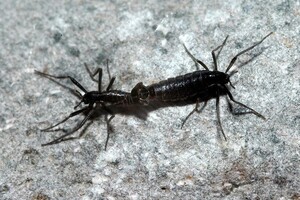Winters are getting warmer, making it harder for insects to survive.

For tens of millions of years, the wingless insect Belgica antarctica has perfected own cold adaptation to survive Antarctica's darkest and coldest months, occupying the unique niche of the continent's only endemic insect.
But temperatures in the polar regions are rising rapidly. So this acquired skill set may, ironically, be detrimental to the insect's very existence, putting it on the brink of extinction, Science Alert reports.
Also read: Antarctica is losing ice at a faster rate than at any time in the last 5,500 years
Scientists from the USA, Great Britain and South Africa conducted laboratory experiments that showed that warmer winters affected the insect's movement and energy reserves, reducing its chances of survival.
The tiny insect's body size does not exceed a centimeter. It spends most of its life in one of four larval stages among moist thickets of moss and algae, eating decaying greens and waste. But even her modest habitat freezes during the harsh Antarctic winters. Therefore, the insect has developed a strategy that allows it not to die under such conditions.
As a defense against injuries caused by ice crystals penetrating its tissues, the midge dries slowly. Under the right conditions, individuals have a good chance of surviving the summer, even after losing up to three-quarters of their moisture.
But these chances depend largely on humidity and whether the creature obtains moisture from water vapor or absorbs it directly from liquid water. . Even small changes in environmental conditions can have serious consequences for its survival.
On the Antarctic Peninsula, the temperature of microclimates, similar to those where the midge lives, varies between -5 and 0 degrees Celsius. Protected by a layer of snow and ice, the temperature outside can drop dramatically, but this will not affect the climate of the mosquito's home.
As the temperature on the island steadily rises by half a degree per decade, these relatively sheltered conditions are subject to change. Warmer temperatures can mean more precipitation, thus more snow, thicker insulation, and less chance of winter freezes.
In the course of the study, scientists collected insect larvae on the outskirts of the station on Anvers Island. Then they were sent to a laboratory in the United States, where they spent six months in conditions that are slightly different from the usual ones: from -5 to -1 degrees Celsius. In addition, they were housed in a variety of environments, from algae to moss.
Individuals were thawed in meltwater and examined for signs of movement, tissue damage, and energy stores of carbohydrates, fats, and proteins.
It turned out that a small difference in temperature greatly affects the recovery of insects. Under typical conditions, about half of the insects survived. Warmed by only a few degrees, only a third survived. Energy reserves also differed significantly: in cold conditions, more fat and protein reserves were stored than in warmer ones.
The scientists note that the larvae that lived in warmer winter conditions were the least active. It was probably due to energy loss.
“Due to the limited time to pupation after winter, and because B. antarctica adults lack a functional mouthparts, depletion of energy stores during late larval stages is likely to have irreversible consequences for the energy available for reproduction,” the scientists said.
At this point, it is difficult to say what will happen if the temperature continues to rise. This can be a minor inconvenience, or a blow that will lead to the extinction of insects.
Previously, scientists conducted a study that showed that rain will soon replace snowfall as the most common type of precipitation in the Arctic. This will happen due to climate changes and warming of the northern polar region of our planet.
See special topic: Global warming may help open a sea route in the Arctic that is not controlled by Russia The Northern Sea Route is currently one of the few ways to sail across the Arctic. Warming in the Arctic: the temperature in the Barents Sea is “off the charts” Scientists believe that this may cause extreme weather events in the USA and Europe. Siberian tundra may disappear due to global warming As temperatures rise, forests will occupy northern areas. The snow-capped Alps are turning green, and the changes are already visible from space This is due to global warming. Eating insects can help tackle climate change: how it's possible Scientists call insects an important source of protein.




